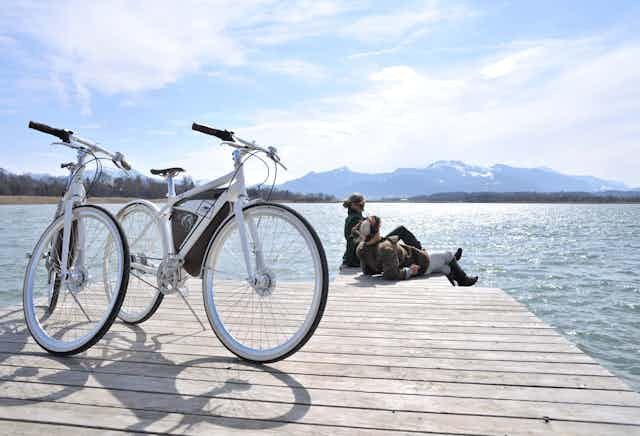If you’ve not ridden an electric bicycle yet, chances are you know someone who has. Or maybe someone rode past you on one and you thought it was a conventional bike. Changes in permitted power output means you’ll likely be seeing more, and better, electric bikes coming your way (or riding past you).
If you’ve been lured by an electric bike, my colleagues and I would like to hear from you, as I’ll discuss a little later. But first, for the uninitiated, let’s start with the basics: what is an electric bike?
An electric bike has motorised assistance that allows the cyclist to ride further with less effort. Think of it as having a reliable tailwind to help you on your way up hills.
The distinct difference is how the motorised assistance works: pedal assist or handlebar throttle. Confusion arises because both pedal assist and handlebar throttle are often referred to as electric bikes, or e-bikes for short.
Pedal-assist or pedelec bikes require the rider to pedal to gain the advantage of the electric model. Put simply, for a pedal-assist bike, no pedalling equals no power.
In contrast, an e-bike with a handlebar throttle, a simple flick of the switch or twist of the handlebar will propel the bike forward – without pedalling.
Electric bike manufacturers and retailers have been building and importing powered bicycles in Australia for more than two decades but a change is in the wind thanks to new government regulations.
A change of gear
In May, the Australian government amended the Australian Design Rules to adopt the European rule (EN 15194:2009), and this changed some of the rules around electric bikes. The biggest change was the increase to their permitted power output from 200 to 250 watts.
Motorised assistance will cut out at 25km/h. You can go faster than 25km/h, but you need to be pedalling – the battery will not provide any extra push.
While some countries, and some states of the US, allow electric bikes of up to 1,000 watts, any bicycle powered by an auxiliary motor that exceeds 250 watts in Australia will be classified a motorbike and must be registered and ridden by a licenced rider.
In addition to further clarifying the definitions of electric bikes, the government’s changes to permitted power outputs have brought Australia inline internationally.
While 50 watts more may not seem a big increase, it’s potentially a game-changer for electric bikes.
For riders, it means going up hills will be a little easier, with extra torque, although the top speed will still cut out at 25km/h and the distance you can ride with electric motor assistance will be about the same.
The real improvement is the variety of electric bikes that can now be sold in Australia.
Out with the old
Internationally, 250 watts is a common standard power output; subsequently, many electric bikes being designed and manufactured globally have 250-watt motors.
As a result, the electric bikes available in Australia until now have been a mixed bag. At one end, small businesses that specialise in custom-built electric bikes offered a quality product that has improved with each new generation of bike, better battery technology and advancements in design.
But the market has been flooded with cheap electric bikes, sold over the internet or imported in containers and sold from warehouses in cardboard packing boxes.
While initially inexpensive for the consumer – in the region of A$1,000 – these products lack after-sales service and support. When something (inevitably) does go wrong, the consumer is left with a very heavy bike.
In with the new
The amended Australian Design Rules mean sophisticated new electric bike designs with the latest technology are legally available, and what was once a boutique industry with a discrete custom market share is about to go mainstream.
Quality electric bikes with excellent after-sales service and support range from A$2,000-A$3,000. More expensive than a standard pushbike, electric bikes are significantly cheaper than many high-end bicycles, which range from A$5,000-A$10,000 and beyond.
Electric bikes are already mainstream in one Australian company – Australia Post. While some companies are replacing one fleet vehicle with e-bikes for short trips made by staff, Australia Post is the poster child for electric bikes with more than 1,000 electric bikes in their fleet.
Australia Post has worked with bicycle designers and manufacturers to improve the design of the bicycle to maximise the safety and efficiency for posties en route – and this has impacted the geometry of the bikes and their luggage capacity.
Each generation of battery also further improves the distance the e-bikes can travel on a single charge.
Get in touch
Our study at the Institute of Transport Studies at Monash University is investigating what influenced people to buy an electric bike and what their experiences have been using them.
Our findings will assist to develop future policies aimed at increasing the safety and sustainability of the transport system, including electric bikes.
Whether the electric bike provides a stepping stone from the car to a pedal bike remains to be seen. But the individual benefits that can be gained by reducing people’s reliance on cars and increasing their physical activity will also help reduce congestion and vehicle exhaust pollution on our roads.
While some bicycle models are clearly electric bikes with a battery pack plain to see, many of the models are not visibly electric and are difficult to differentiate for other road users.
As with all cycling activity, the question of safety also impacts electric bike riders and feeds into the issue of adequate and connected bicycle facilities on and off roads, as well as behavioural issues with other road users.
So you ride an electric bike, or know someone who does? Do let us know and, of course, safe riding!
You can participate in this study online.

